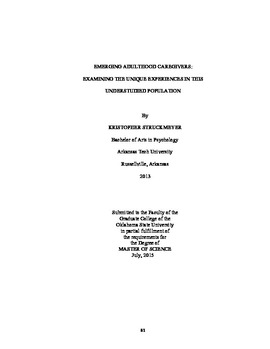| dc.description.abstract | The majority of caregiving literature either focuses on child and teenage caregivers (Shifren, 2009) or middle and late adulthood caregivers (Blum & Sherman, 2010; Bastawrous, 2013). Because of the skewed focus, emerging adulthood caregivers are poorly represented in research and practice. Categorizing caregivers as either young or adult caregiver aids policymakers to develop general services; however the caregiving categories encompass two or more developmental periods. Assuming a caregiving role at an unexpected time during the life course can interfere with the psychosocial tasks of a given life stage; creating a disruption and causing the caregiver to feel �off-time.� The purpose of this study was to explore the characteristics of emerging adulthood caregivers to determine how the caregiving role impacts this population. The sample for this study (n=118) was a convenient sample of students recruited from large undergraduate university courses. The Caregiver Well-being Scale-Short Form, Zarit Burden Interview, Positive and Negative Affect Schedule, and the Life Experiences Survey, as well as two original scales were used to assess constructs of caregiving activity, caregiver well-being, psychological affect, health literacy, caregiver burden, and transitions. Results show that unemployed, single, white females are more likely to provide care. Quantity of transitions was not found to influence psychological affect or caregiver burden. Caregiving activity was correlated with caregiver burden such that higher levels of burden were correlated with higher levels of burden. However, caregiving activity was not correlated with well-being or psychological affect. Emerging adulthood caregivers typically do not perform the primary caregiving role, yet the individuals occupying the secondary and tertiary roles can still experience strain or overload. Even though caregiving was defined for them at the beginning of the study, emerging adults either reported that they did not identify themselves as a caregiver due to familial obligations or incorporated their own views and past experiences into the definition of a caregiver. Further research is needed to focus on primary emerging adulthood caregivers to determine the risks and benefits of this population. By understanding the emerging adulthood caregiving population, more beneficial services can be developed to aid this population. | |
